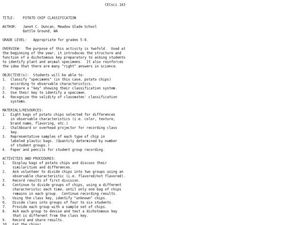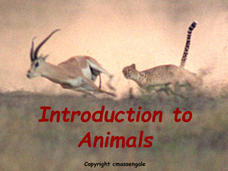Curated OER
Cell Discoveries
Students observe, compare and describe cell organelles in terms of their function, structure and operation. They enter and edit information in a database, build and sort a student-designed database and find records in a database.
Curated OER
Let's Get Carried Away
Students discover how seeds travel from their parent plants in search of water, sunlight, and nutrients, and conduct experiments in which they note characteristics that encourage seed dispersal by means of wind, water, animal carriers,...
Curated OER
Shapes
Students identify attributes of different geometric shapes. In this geometry lesson, students view a PowerPoint presentation on shapes and use attribute blocks to examine the corners and edges of each shape. Students work together...
Curated OER
Learning the Causes of Extinction
Students are introduced to the five major reasons for extinction. In groups, they read scenarios and divide them into different categories. Using the internet, they identify which reason a certain animal became extinct. To end the...
Curated OER
What Happened to Robin?
Students investigate animal injuries caused by humans. They present their findings to various neighborhood groups.
Alabama Learning Exchange
The Grouchy Ladybug
Learners listen to the book, "The Grouchy Ladybug" by Eric Carle and sequence the events in the story. Using a graph, they draw and color the animals that the ladybug meets next to the corresponding time from the story, and conduct...
Curated OER
What's Wild
Third graders discover the differences between wild and domestic animals. In this animal lesson, 3rd graders chart the differences in the animals and look through magazines for pictures of wild and domestic animals to glue to a poster....
Curated OER
Act of Sabotage?
Students examine animal cruelty laws in Great Britain. In this health lesson, students visit selected websites to research animal cruelty laws as they consider animal rights and hunting rights.
Curated OER
What's Wild?
Third graders define domesticated animal and wildlife. In this animal lesson, 3rd graders cut pictures out of magazines of both types of animals and make two collages with the pictures.
Curated OER
Insects!
Students explore the diet of insects. In this "insects" biology lesson, students take a nature walk and collect various natural materials they think may be eaten by insects. Students sort and classify these materials into three diet...
Curated OER
Potato chip Classification
Students create a dichotomous key using potato chips. In this classification lesson plan, students sort potato chips into groups based on observable characteristics. They record their results to create a dichotomous key in preparation...
Curated OER
Agriculture Counts
Students discuss the kinds of things they count and how to use tally marks. In this social science lesson, students count animal crackers by using tally marks for each kind of animal. The tally marks are changed into numbers and one...
Curated OER
Investigating Local Ecosystems
Learners observe a local area for living organisms and their habitats. In this local ecosystems lesson, students complete an online field journal. Learners share their findings and sort them into categories. Students visit a...
Curated OER
Nature and You
Students recognize the story of creation in the Bible and begin to discuss endangered animals. In this creation lesson, students focus on a specific species that is endangered and complete a worksheet on how to save them. Students make...
Curated OER
Animals Active at Night
Students identify animals that are active at night and the reasons why. They examine the features needed to be a nocturnal animal. They create a representation of one of the animals.
Curated OER
Badminton Techniques
This lesson includes visuals and animations designed to aid the instructor or coach to help students learn to use correct techniques in playing badminton. Visuals include drills, tutorials, and exhibitions suitable for all levels of play...
Curated OER
Safe Or Sorry-- Risky And Non- Risky Lunch Box Choices
In this health worksheet, students discover that some foods are safe to have in a lunch box at room temperature, and some foods are risky and need a cold pack. Students sort common foods as risky (and tell the reason why) or safe....
Curated OER
Life Cycle: Diversity in a Balance 4th Grade Workbook
In this life cycle workbook, 5th graders examine plant and animal cells, classification of organisms, human biology, photosynthesis, and natural environments. 21 different activities make up the Life Cycle Workbook.
Curated OER
2-D and 3-D Presents at Pedro's Party
Fifth graders draw 2-D and 3-D shapes. They sketch and label geometric figures with correct terminology, then explore parallel and perpendicular lines. Pupils sort and classify shapes drawn.
Lerner Publishing
Meet the Dinosaurs
Take your class of youngsters on a prehistoric adventure with this four-lesson series on dinosaurs. Accompanying the Meet the Dinosaurs books by Don Lessem, these lessons engage children in writing their own dinosaur books,...
Biology Junction
Introduction to Animals
Out of all animals, elephants alone lack the ability to jump. Scholars learn all about animals using a presentation full of fun examples. It describes different types of animals, the biological similarities and differences between...
Curated OER
Pancakes, Anyone?
First graders explore data collecting and graphing. In this data collecting and graping instructional activity, 1st graders watch a video about monster who sells pancakes. Students make a graph to record the most popular pancake....
Curated OER
Fabulous Felines
Students explore the behaviors of cats. For this cat study lesson, students find answers to questions about cat behavior. Students may also participate in cat trivia.
Curated OER
Getting Food
Learners explore seashore ecosystems. In this marine animal biology activity, students sort photographs of various sea creatures according to their eating habits and discuss each animal's identifiable traits. Learners draw...























